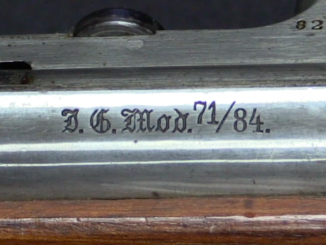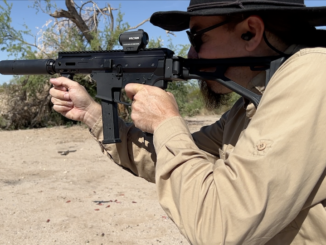As the Second World War started to really take a toll on German industrial production, several companies started to work on alternatives to the P38 handgun in an effort to reduce production cost and time. This is one such example made by Walther, with a normal type of milled slide and an experimental frame made from stamped sheet steel. It uses a rotating barrel mechanism taken from Nickl (and the Steyr-Hahn before him), and uses standard P38 magazines. None of these designs actually made it into production before the end of the war.
Related Articles

Bolt Action Rifles
Gewehr 71/84: Germany’s Transitional Repeating Rifle

Patent drawings
Bergmann No.5 / 1897 Pistol

Semiauto Rifles

Thanks Ian. Your site is going to be the most serious reachable reference for firearm technology and development. The Walther’s rotating barrel approach, though absolutely unknown, should be the simplest and strongest construction ever designed. Barrel bushing unneeded muzzle closure, takedown key functioned camming bolt are both ingenious and user friendly since leaving less parts wrangling around after the dismounting. It seems,if ıt were manufactured, it should be the most copied rotating barrel action. Stamped sheet manufacturing, apart with in some little parts which is still common in modern technology, appears as being used to form the most costy and hard part of any pistol, the frame, and solely to close and integrate the both sides with plates through rivets. This applcation is transmitted to Plastic Injection Process in Today’s trend and if this pistol goes to be manufactured again via this way through with current trigger demands, it should be a winner. It is a pity that Walther did not reintroduced this rotating barrel engagement at the ages of “Wondernines”, instead of selecting common tilted barrel type as leaving own dropping block construction. It would deserve more for a brand of such rich past.
The discolored spot on the slide opposite the ejection port strongly suggests that Walther engineers had to flame harden the slide locking lugs after completing the pistol. Must have experienced excessive locking lug wear during initial firing. Engineering development before the age of computational methods. MG.42 demonstrates far more sophisticated engineering development, and that was the product of a bunch of washing machine engineers!
Great stuff, Ian. I am very curious to learn more about the experiments to create a stamped sheet-metal revolver for the Volkssturm. Do you have any more info or can you point me to a reference? Thanks!
The only two sources I am aware of are the Collector Grade books “Mauser Pistolen” and “Desperate Measures”, neither of which have very much. There are hopefully some better resources out there I’ not aware of (maybe in German?). My understanding is that none of the guns survive today.
thanks I was about to ask about books to look for
Alright, what would happen if this pistol was on the commercial market today? Would it be made with stampings or polymer to balance durability and ease of manufacture?
In Ezell’s book (Handguns of the World), there’s a picture of a later Walther Volkspistol on p. 674. It’s identical to this one except that the slide is also stamped from sheet steel. (This pistol, 3B, or one exactly like it with the machined-steel slide is shown on p.673.)
Walther also made a stamped-steel version of the prewar Armee Pistol (P.38 type with fully-enclosed hammer like a Colt M1903 pocket automatic). It’s shown on p.672. (Ezell states that it dates to 1939, but according to John Walter in Guns of the Third Reich, it actually dates much later, to the fall of 1944.)
Mauser made at least one HsC in .32 with a stamped-steel slide.
Even the U.S. had at least one stamped-steel pistol besides the FP45 Liberator .45 single-shot. Springfield built a dozen prototype stamped-steel 1911-type .45s in 1943.
Stamping is a less likely route today. Investment casting, steel sintering, or even 3D printing would get virtually the same result as machining from the solid for about the same materiel expenditure as stamping, and the result would probably be just as strong but with lighter weight. In terms of elapsed time, the processes finish up just about even.
One overlooked method is represented by the old H&K VP-70 and P9S. Their slides were literally welded up from flat pieces that were then machined to shape. The P9S steel frame was also built in this way.
The VP-70 had a moulded polymer frame, predating the Glock by seven years. And nobody at the time ever accused it of being “invisible to metal detectors”. Or anything else, FTM: a VP-70 is about as easily concealed as a live moose in your refrigerator.
Interestingly, this exact method in a cruder form has been used by “Paltik” gunmakers in the Philippines for decades. They bend a flattened steel rod to the outline of the frame they want, then cut side pieces to match from mild steel sheet and weld or even braze them in place.
These techniques may be old, but they may also be the way of the future in gun manufacture.
cheers
eon
What a neat pistol.
and what a loss that it never had any post war progeny.
It is interesting that it appears to have a higher bore line than the BSA pistol you covered a few days back.
Was the lockwork of the Walther double action?
Always neat to see something really different from a mechanical perspective–thanks!
In retrospect, this pistol could have very well being a better choice for the post-war West German Bundeswehr than the somewhat problematic aluminum frame version of the P38 (the P1) they actually adopted in the 1950s. I wonder if Walther even offered it or were blueprints and other documentation lost during the post war chaos and Soviet confiscation of Walther’s machinery and documents.
It’s amazing what the Germans could come up with late in the war, when so much of their industry (and manpower) were being destroyed on two fronts, as well as the lack of available resources. This pistol looks to be a viable combat weapon compared to some of the cruder stamped Volkspistolen to come out later. The MG 42, MP 40, and even the 30mm MK 108 cannon (and the Me 262 jet that carried them) were all quite serviceable weapons created without precedent. Comparatively, the M3 SMG and the various stamped 1911s were barely adequate, and in the case of the stamped 1911s, almost comical in their awkwardness and crude appearance. Politics aside, it was an amazing logistical and technical effort, proving that necessity really is the mother of invention. There is some truly fantastic stuff coming out of that auction.
The problem was that the German R&D and procurement “system” was generally in utter chaos with alternating periods of dozens of organizations working on the same issues, to arbitrary cutoffs of research that probably killed promising developments.
But then that’s what you get when put the equivalent of a Mafia crew in charge of one of the biggest economies in Europe…
It is fascinating how ww2 war effort in all civilised countries that were engaged in a fight produced so much in so little time. Things were researched and developed in a few years timespan (or shorter), feat that would take todays bureaucratic industrial standards decades, if not more, and millions of cash (which is in a great deal spent unwisely and with great deal of corruption).
German industrial basis was mostly destroyed, but they could not destroy the efforts and inventions they comed up to 1945. – they (Soviets and USA) just took the work the germans spent money and time and upgraded it.
Highly unlikely that a world would see such economic boom after the 40s, if the war never happened.
Same thing you could relate to cold war- massive army spending in R&D of new weapons spawned also a great benefits to regular civilian users, when the military tech was transfered to them (for example, home computers, or internet!).
What is an interest to me, is to see some data of the cost of the production of this Walther pistol compared to standard p38, if thats available.
I dont have the exact data, but in some publications they’ve comed up with the fact that in the war extremely low number of enemy battle casualties are caused directly by pistols, thus giving a good question of real value of making and developing a pistol in a wartime.
The MK 108 had an API blowback operation, which was hardly anything new at the time. The cannon was certainly well engineered for compactness, but in general it was not especially innovative.
The real German autocannon innovation, if you don’t mind me saying so, was the 20/30mm MG/MK 213C revolver cannon, which was copied after the war by all Western Allies. The revolver action allowed for a higher rate of fire than any linear action gun. All European fighter aircraft cannons today (DEFA, ADEN, Oerlikon & Mauser) are still based on the revolver principle.
Seems to be missing something on the left side of the slide as well as a pin hole, did it possibly have a loaded chamber indicator as well?
The takedown plunger’s fit as part of the rotation cam doesn’t look like its even close…was the tolerance low enough that just having a vague angle to it was enough?